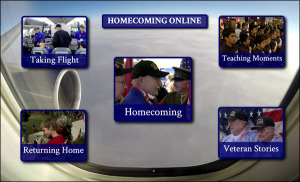Convergence Class Readies Long-Length Video for Mobile Devices
The 30-Minute Documentary ‘Homecoming’ Can Be Viewed on Small Mobile Screens
By Rebecca Dell
Columbia, Mo. (Dec. 1, 2014) — The stories of the veterans in the documentary “Homecoming,” says Missouri School of Journalism senior Marissanne Lewis-Thompson, “take my breath away.”
This fall, Lewis-Thompson is part of a convergence journalism capstone team at the School looking at new ways to present documentaries on mobile devices. “Homecoming” tells the stories of returned veterans who return home after service and find they have to relearn how to live a normal life. The team, composed of Lewis-Thompson and fellow seniors Joe McLean and Tyler Castner, spent September and October taking the 30-minute documentary and figuring out how to present it attractively on the small screens and with the limited data plans of mobile devices.
“We call it mobilizing a documentary, but really what we’re doing is we’re reimagining how content can be consumed,” said Judd Slivka, an assistant professor of convergence journalism and the faculty mentor for the project.

When the team members got the materials, they sorted the documentary into five categories: Taking Flight, Teaching Moments, Veteran Stories, Returning Home and Homecoming. The team then figured out how to link the categories and provide an interactive experience using a software program developed in France and new to the U.S. called Klynt. Precious weeks were spent on sorting out the technology: watching tutorials and webinars, teaching each other and learning by trial and error.
“We really had no other way of learning it, other than the Missouri Method,” Lewis-Thompson said. “We learned by doing.”
They had in mind a mobile, easily digestible experience that would preserve the integrity of the original film.
“We wanted to try to capture the moments and the feelings that we had watching the documentary without mimicking the exact format,” Castner said.
The project is happening via a partnership with Nebraska Educational Telecommunications, or NET, the state’s main NPR and PBS affiliate. NET boasts a television audience of over a million people weekly, with 12 hours of educational programming every weekday. Among NET’s many accolades were three first-place awards from the 2014 Nebraska Broadcasters Association Pinnacle Awards in categories including Service to Community. The team says the producers of the documentary offered feedback while allowing the team to truly experiment and explore new mobile possibilities.
Slivka started exploring the concept with NET’s associate general manager at Reynolds Journalism Institute‘s Mobile First conference in spring of 2014. Over the summer, the film “Homecoming” was chosen. It features veterans from the Korean War and World War II talking about their experiences coming home from war.
The three students volunteered for the section and brought proficiencies in audio, video editing and problem solving. They were ready to brainstorm an innovative approach with a tight turnaround.
“Do we make it controllable, where they can skip forward, where they can move around?” Slivka asked early in the process. “Do we make it where we replace a lot of the video with text, which is easily scannable, and then automatically pop in video? Do we create interactive graphics that let people select where they want to go?”
With the mobile release of the documentary, the class will spend several weeks examining user analytics.
The project focused on production and presentation. It complements other convergence journalism classes that focus on the gathering and editing end of journalism. Other capstone classes have done analytics for news outlets, developed and implemented social media plans, adapted 3-D technology to journalism and more.
As the new documentary journalism program at the Missouri School of Journalism is established, Castner imagines the team’s innovations applying to media here and elsewhere. “It can create a way for us to make a non-mobile experience mobile,” he said.
Updated: July 31, 2020